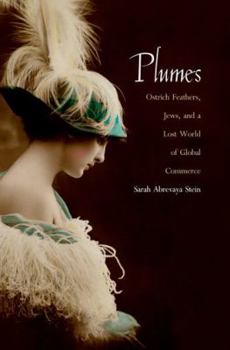Plumes: Ostrich Feathers, Jews, and a Lost World of Global Commerce
The thirst for exotic ornament among fashionable women in the metropoles of Europe and America prompted a bustling global trade in ostrich feathers that flourished from the 1880s until the First World... This description may be from another edition of this product.
Format:Hardcover
Language:English
ISBN:0300127367
ISBN13:9780300127362
Release Date:November 2008
Publisher:Yale University Press
Length:244 Pages
Weight:2.00 lbs.
Dimensions:0.9" x 6.4" x 9.5"
Customer Reviews
3 ratings
Wonderful history
Published by Thriftbooks.com User , 14 years ago
This is both a history of the ostrich feather trade, and also a history of the Jews throughout Northern Africa and also South Africa. Hard to belive that Ostrich feathers were as valuable as diamonds early in the 20th century. Wonderful read.
Feathers and Folly
Published by Thriftbooks.com User , 15 years ago
Why is it that diamonds are regarded as high value and feathers are not? It seems like a silly question, unless one takes into account the foibles of human enthusiasms and the price tags we put on them. One hundred years ago, ostrich feathers were worth almost as much by weight as diamonds, and businessmen argued that they were equivalent in durability. A fine ostrich feather was "an investment for life" wrote one observer at the time, and went on that the plume "has been in fashion for centuries past, and will probably be for centuries to come. It holds its place like the diamond." Ostrich feathers have, of course, faded from fashion, but any bubble can make an interesting study of human behavior. Sarah Abrevaya Stein has done that, and more, in _Plumes: Ostrich Feathers, Jews, and a Lost World of Global Commerce_ (Yale University Press). Stein, a professor who concentrates on Jewish Studies, takes a look at this episode which has not only been forgotten but its Jewish origins have been forgotten, too. _Plumes_ is an academic treatise, full of footnotes and wide research, but the peculiarity of its topic makes it funny and sad as well. Not only that, but studying of the feather bust is probably healthful for those of us a hundred years later who have our own economic woes. Feathers had adorned hats and clothes for centuries, but in the 1880s they became a fashion essential, used on women's large, elaborate hats and on boas. The South African trade in ostrich feathers was coincident with the boom of the area in diamond and gold mines. Stein shows that Jewish workers, traders, manufacturers, and financiers were all involved in the feather trade. Her review shows that this was a process of history rather than any coordinated Jewish effort; Jews had spread out and had mercantile, lingual, and industrial skills that could flourish in new areas. "Jews brought certain elements of human capital to the ostrich feather trade: background in like industries, contacts of kith and kin within and across sub-ethnic diasporas and political and oceanic boundaries, copacetic relations with the reigning authorities, geographic mobility, and, no less important, economic need." That there could be this sort of Jewish involvement made it almost inevitable that some would use it as a focus for anti-Semitic thought, but it is hard to see any great conspiracy at this remove, especially since any such conspiracy would have to be one of the least successful ever. Before the bust things looked bright indeed. The harvesting and preparation of the feathers was surprisingly complicated, and the industry employed thousands. A big problem for American ostrich feather manufacturers was that there were import duties to be paid on feathers from London, so that ostrich farms sprang up in the South and Southwest. Governmental aid for such farms was sought, one Arizona representative declaring to his colleagues in the House in 1913, "No one need have any fear for th
fascinating thorough work
Published by Thriftbooks.com User , 15 years ago
I write this without the book because I have given it away as a prize in a raffle, I think so much of it. The research was particularly thorough - the footnotes are as interesting as the text. I liked this book better than any other thesis turned into a book because it is so well written - her rhythm, vocabulary and personal voice are all excellent. The material is particularly fascinating, especially as I have an ostrich feather fan and a single plume inherited from my great-grandmother, and I am sure that people tried to establish ostrich farms in Australia before WW1, just as the South African farmers took our - South Australian - wattle seed at that time and set up wattle farms for the bark used in tanning, and killed an industry here because they had cheap (slave) labour. But her main argument - that the Jews who ran the industry were particularly suited to it through the training they had received in similar European industries, because of the Jewish diaspora and because of the opportunities they had to set up an industry from the beginning and all the way along, that their languages - Yiddish and Judaeo-Arabic - allowed them to communicate with others significant to the trade - I loved this argument, answering the implicit anti-Semitism of any comment on Jewish control of any industry. The thinking, knowledge and wisdom of that position are inspirational, and evoke my gratitude. And my admiration. This is such an excellent work. And she illustrates this argument with detailed knowledge of the industry, drawn from its records and personal letters, showing its development through Africa (I wanted to know more about the desert camel trains, carrying huge bags of feathers) and the development of the markets, in Europe and America, through family and relationship contacts. i heartily recommend this book - I loved it.




